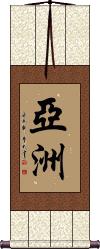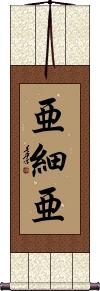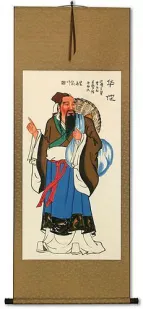Many custom options...
And formats...

Asia in Chinese / Japanese...
Buy an Asia calligraphy wall scroll here!
Personalize your custom “Asia” project by clicking the button next to your favorite “Asia” title below...
Asia / Asian Continent
Asia / Asian Continent
This in-stock artwork might be what you are looking for, and ships right away...
Gallery Price: $200.00
Your Price: $79.88
Not the results for asia that you were looking for?
Below are some entries from our dictionary that may match your asia search...
| Characters If shown, 2nd row is Simp. Chinese |
Pronunciation Romanization |
Simple Dictionary Definition |
胡 see styles |
hú hu2 hu ko こ |
More info & calligraphy: Hu(hist) barbarian tribes surrounding ancient China; (surname) Fu; (surname) Hu How? Why? Hun; Turk; random; hemp; long-lived; pepper, etc.; translit. go, hu. |
亞洲 亚洲 see styles |
yà zhōu ya4 zhou1 ya chou |
More info & calligraphy: Asia / Asian Continent |
西亞 西亚 see styles |
xī yà xi1 ya4 hsi ya |
More info & calligraphy: Siah |
アジア see styles |
ajia アジア |
More info & calligraphy: Azia |
亜細亜 see styles |
ajia アジア |
More info & calligraphy: Asia / Asian Continent |
アーシア see styles |
aashia / ashia アーシア |
More info & calligraphy: Aasia |
亜 see styles |
yà ya4 ya mitsuru みつる |
Japanese variant of 亞|亚 (prefix) (1) sub-; second-rate; inferior; (prefix) (2) {chem} -ous (indicating a low oxidation state); -ite; (3) (abbreviation) (See 亜細亜・アジア) Asia; (4) (abbreviation) (See 亜爾然丁・アルゼンチン) Argentina; (5) (abbreviation) (See 亜剌比亜・アラビア) Arabia; (6) (abbreviation) (obsolete) (used in Meiji era, now replaced by 米) (See 亜米利加・アメリカ・1,米・べい) America; American person; (given name) Mitsuru |
佤 see styles |
wǎ wa3 wa |
Wa, Kawa or Va ethnic group of Myanmar, south China and southeast Asia |
蕹 see styles |
wèng weng4 weng |
water spinach or ong choy (Ipomoea aquatica), used as a vegetable in south China and southeast Asia; Taiwan pr. [yong1] |
鯝 鲴 see styles |
gù gu4 ku |
Xenocypris, genus of cyprinid fish found in eastern Asia |
鰁 鳈 see styles |
quán quan2 ch`üan chüan |
fish of genus Sarcocheilichthys (a genus of cyprinid fishes found in eastern Asia) |
䲘 鳤 see styles |
guǎn guan3 kuan |
Ochetobius elongatus, species of cyprinid fish found in eastern Asia |
中亞 中亚 see styles |
zhōng yà zhong1 ya4 chung ya |
Central Asia |
亜大 see styles |
adai あだい |
(org) Asia University (abbreviation); (o) Asia University (abbreviation) |
亜州 see styles |
ashuu / ashu あしゅう |
(dated) Asia; (given name) Ashuu |
亜欧 see styles |
aou / ao あおう |
Asia and Europe; Eurasia |
亞太 亚太 see styles |
yà tài ya4 tai4 ya t`ai ya tai |
Asia-Pacific |
佛陀 see styles |
fó tuó fo2 tuo2 fo t`o fo to budda |
Buddha (a person who has attained Buddhahood, or specifically Siddhartha Gautama) v. 佛 There are numerous monks from India and Central Asia bearing this as part of their names. |
佤族 see styles |
wǎ zú wa3 zu2 wa tsu |
Wa, Kawa or Va ethnic group of Myanmar, south China and southeast Asia |
北亞 北亚 see styles |
běi yà bei3 ya4 pei ya |
North Asia |
南亞 南亚 see styles |
nán yà nan2 ya4 nan ya |
southern Asia |
南方 see styles |
nán fāng nan2 fang1 nan fang minamigata みなみがた |
south; southern direction; (in China) southern regions, often referring to areas south of the Yangtze River (noun - becomes adjective with の) (1) the south; southward; southern direction; (2) countries in the south (esp. Southeast Asia and the pre-WWII South Pacific Mandate); (place-name) Minamigata The southern quarter; south. |
南洋 see styles |
nán yáng nan2 yang2 nan yang minahiro みなひろ |
Southeast Asia; South seas South Seas; (personal name) Minahiro |
南蛮 see styles |
nanban なんばん |
(1) (hist) (derogatory term) southern barbarians (name used in ancient China for non-Chinese ethnic groups to the south); (2) (hist) South-East Asian countries (in the late-Muromachi and Edo periods); (3) (hist) Western Europe (esp. Spain and Portugal and their South-East Asian colonies; late-Muromachi and Edo periods); (prefix noun) (4) (hist) foreign (of goods from South-East Asia and Western Europe); exotic (esp. in a Western European or South-East Asian style); (5) (See 唐辛子・1) chili pepper; (6) (abbreviation) {food} (See 南蛮煮・2) nanban; dish prepared using chili peppers and Welsh onions; (7) thrusting the right foot and right arm forward at the same time (or left foot and left arm; in kabuki, dance, puppetry, etc.) |
南詔 南诏 see styles |
nán zhào nan2 zhao4 nan chao |
Nanzhao kingdom 738-937 in southwest China and southeast Asia |
叻沙 see styles |
lè shā le4 sha1 le sha |
laksa, spicy noodle soup of Southeast Asia |
和僑 see styles |
wakyou / wakyo わきょう |
Japanese person living and working abroad (esp. in Asia as a business person) |
哈密 see styles |
hā mì ha1 mi4 ha mi Gōmitsu |
see 哈密市[Ha1 mi4 Shi4] Hami, 'an ancient city and kingdom in Central Asia north-east of lake Lop in Lat. 43゜3 N., Long, 93°10 E.' Eitel. From Han to Tang times known as I-wu 伊吾, now called Kumul by Turki Mohammadans. For more than 1500 years, owing to its location and supply of water, Hami was a bridgehead for the expansion and control of the outposts of the Chinese empire in Central Asia. |
喇沙 see styles |
lǎ shā la3 sha1 la sha |
laksa, spicy noodle soup of Southeast Asia |
大乘 see styles |
dà shèng da4 sheng4 ta sheng oonori おおのり |
Mahayana, the Great Vehicle; Buddhism based on the Mayahana sutras, as spread to Central Asia, China and beyond; also pr. [Da4 cheng2] (surname) Oonori Mahāyāna; also called 上乘; 妙乘; 勝乘; 無上乘; 無上上乘; 不惡乘; 無等乘, 無等等乘; 摩訶衍 The great yāna, wain, or conveyance, or the greater vehicle in comparison with the 小乘 Hīnayāna. It indicates universalism, or Salvation for all, for all are Buddha and will attain bodhi. It is the form of Buddhism prevalent in Tibet, Mongolia, China, Korea, Japan, and in other places in the Far East. It is also called Northern Buddhism. It is interpreted as 大教 the greater teaching as compared with 小教 the smaller, or inferior. Hīnayāna, which is undoubtedly nearer to the original teaching of the Buddha, is unfairly described as an endeavour to seek nirvana through an ash-covered body, an extinguished intellect, and solitariness; its followers are sravakas and pratyekabuddhas (i.e. those who are striving for their own deliverance through ascetic works). Mahāyāna, on the other hand, is described as seeking to find and extend all knowledge, and, in certain schools, to lead all to Buddhahood. It has a conception of an Eternal Buddha, or Buddhahood as Eternal (Adi-Buddha), but its especial doctrines are, inter alia, (a) the bodhisattvas 菩薩 , i.e. beings who deny themselves final Nirvana until, according to their vows, they have first saved all the living; (b) salvation by faith in, or invocation of the Buddhas or bodhisattvas; (c) Paradise as a nirvana of bliss in the company of Buddhas, bodhisattvas, saints, and believers. Hīnayāna is sometimes described as 自利 self-benefiting, and Mahāyāna as 自利利他 self-benefit for the benefit of others, unlimited altruism and pity being the theory of Mahāyāna. There is a further division into one-yana and three-yanas: the trīyāna may be śrāvaka, pratyeka-buddha, and bodhisattva, represented by a goat, deer, or bullock cart; the one-yāna is that represented by the Lotus School as the one doctrine of the Buddha, which had been variously taught by him according to the capacity of his hearers, v. 方便. Though Mahāyāna tendencies are seen in later forms of the older Buddhism, the foundation of Mahāyāna has been attributed to Nāgārjuna 龍樹. "The characteristics of this system are an excess of transcendental speculation tending to abstract nihilism, and the substitution of fanciful degrees of meditation and contemplation (v. Samādhi and Dhyāna) in place of the practical asceticism of the Hīnayāna school."[Eitel 68-9.] Two of its foundation books are the 起信論and the 妙法蓮華經 but a larnge numberof Mahāyāna sutras are ascribed to the Buddha。. |
Click here for more asia results from our dictionary
The following table may be helpful for those studying Chinese or Japanese...
| Title | Characters | Romaji (Romanized Japanese) | Various forms of Romanized Chinese | |
| Asia Asian Continent | 亞洲 亚洲 | yà zhōu / ya4 zhou1 / ya zhou / yazhou | ya chou / yachou | |
| Asia Asian Continent | 亜細亜 | a ji a / ajia | ||
| In some entries above you will see that characters have different versions above and below a line. In these cases, the characters above the line are Traditional Chinese, while the ones below are Simplified Chinese. | ||||
Successful Chinese Character and Japanese Kanji calligraphy searches within the last few hours...






